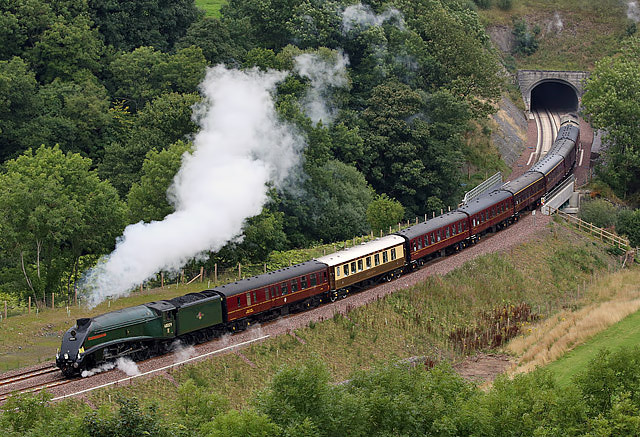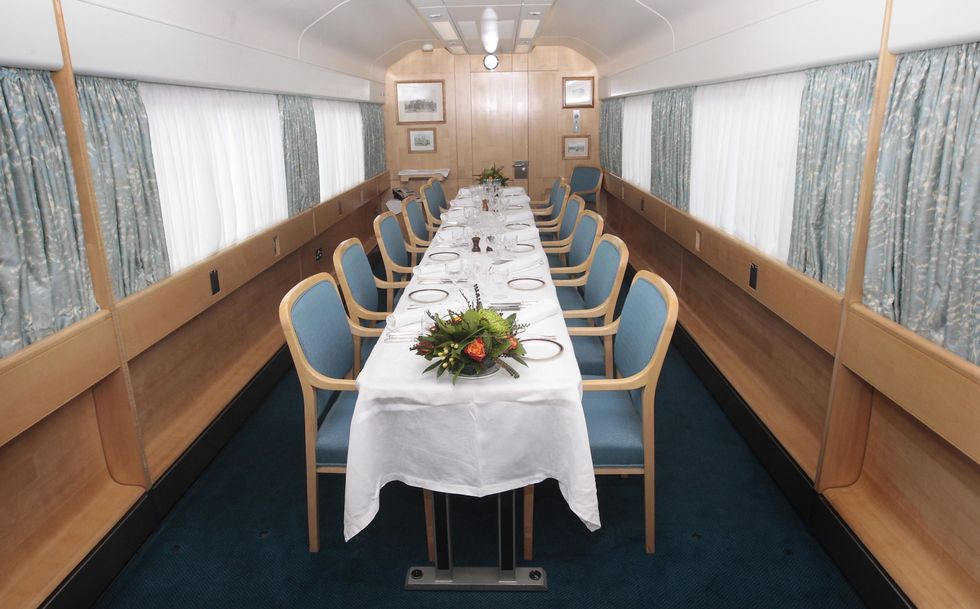Wish I had enough money and/or a title to ride this Train!

 Climb aboard for an inside look at the history of the "palace on wheels," from its lavish past as the royal "express of excess" to His Majesty King Charles III's mobile home away from home.
Climb aboard for an inside look at the history of the "palace on wheels," from its lavish past as the royal "express of excess" to His Majesty King Charles III's mobile home away from home. 
By Lauren Hubbard - Town & Country - 15 Nov 2020
"When it comes to travel, the royal family are hardly lacking in options. Though the royal yacht, Britannia, was decommissioned in 1997, they still count amongst their collection another equally historic mode of transport—the Royal Train.
Queen Victoria became the first royal to take a train in 1842. Though her husband Prince Albert was a great fan of locomotives, Victoria was initially a little more reticent about the idea of a royal train. It was only at Albert's urging that, at the age of 23, she finally agreed to try it out, becoming the first royal ever to travel by rail when she took a train from Slough to Paddington.
"[The Royal Train] was vitally important to Victoria's reign," explains royal historian Kate Williams. "She saw traveling the country as her duty, whereas monarchs didn't necessarily think that before. They were quite happy to sit in their palaces and not really go touring. Victoria has a completely different attitude, in which she feels very strongly that it's her job to go traveling around as much of Britain as she can, so the Royal Train makes it easier for her."

The Royal Locomotive

The Royal Train

One of the Drawing Rooms aboard the Royal Train

The Dining Room aboard the Royal Train

The Smoking Room aboard the Royal Train

Staff Quarters aboard the Royal Train

The Kings Office aboard the Royal Train
"[The Royal Train] was vitally important to Victoria's reign," explains royal historian Kate Williams. "She saw traveling the country as her duty, whereas monarchs didn't necessarily think that before.
They were quite happy to sit in their palaces and not really go touring. Victoria has a completely different attitude, in which she feels very strongly that it's her job to go traveling around as much of Britain as she can, so the Royal Train makes it easier for her."
The Royal Train was a state secret until 1946.
Understandably, information about royals travels has historically been carefully guarded, and the Royal Train was no exception for much of its life. During WWI, King George V, Queen Elizabeth II's grandfather, used it not only to travel around the country but also as lodgings, as he felt it was inappropriate to ask his subjects to arrange accommodations for him during those resource-strapped times, according to Williams.
Likewise, his son, King George VI, used it to visit areas of the country that were being bombed by the Germans during WWII. That decision led to a major refurbishment of the train for security reasons, replacing the white-roofed wooden cars with a 56-ton armor plated version filled with security measures, including special cabinets to store top secret documents.
The nine-carriage train is somewhat fancier than your average UK commuter service, with a 12-person dining carriage, an office for the monarch to work from, and multiple bedrooms and bathrooms.
Its polished livery is painted in a shade known as “royal claret”; though in documentaries over the years, former staff have described the interiors as being decorated with items “you could find in Homebase or B&Q”.
The monarch’s private carriage features a single bed, private bathroom, desk and a full-sized bathtub.
[...] It's never been the speediest.
When it comes to royal train travel, don't expect breakneck speeds. Queen Victoria set strict limits on how fast she would allow the Royal Train to travel—40 miles per hour during the daytime, 30 at night.
This may have been due to a widely held belief at the time that moving at too high a rate of speed might render a
person insane.
The train is mostly used by senior royals, who must be invited aboard by the reigning monarch.

King Charles boards the train
The monarch’s private carriage features a single bed, private bathroom, desk and a full-sized bathtub".
Works Cited: The Royal Train
 "[Trains] will take you back to a time when life was not so full of care and there was time to stand and stare". Ruskin Bond
"[Trains] will take you back to a time when life was not so full of care and there was time to stand and stare". Ruskin Bond


By Lauren Hubbard - Town & Country - 15 Nov 2020
"When it comes to travel, the royal family are hardly lacking in options. Though the royal yacht, Britannia, was decommissioned in 1997, they still count amongst their collection another equally historic mode of transport—the Royal Train.
Queen Victoria became the first royal to take a train in 1842. Though her husband Prince Albert was a great fan of locomotives, Victoria was initially a little more reticent about the idea of a royal train. It was only at Albert's urging that, at the age of 23, she finally agreed to try it out, becoming the first royal ever to travel by rail when she took a train from Slough to Paddington.
"[The Royal Train] was vitally important to Victoria's reign," explains royal historian Kate Williams. "She saw traveling the country as her duty, whereas monarchs didn't necessarily think that before. They were quite happy to sit in their palaces and not really go touring. Victoria has a completely different attitude, in which she feels very strongly that it's her job to go traveling around as much of Britain as she can, so the Royal Train makes it easier for her."

The Royal Locomotive

The Royal Train
One of the Drawing Rooms aboard the Royal Train

The Dining Room aboard the Royal Train

The Smoking Room aboard the Royal Train

Staff Quarters aboard the Royal Train

The Kings Office aboard the Royal Train
"[The Royal Train] was vitally important to Victoria's reign," explains royal historian Kate Williams. "She saw traveling the country as her duty, whereas monarchs didn't necessarily think that before.
They were quite happy to sit in their palaces and not really go touring. Victoria has a completely different attitude, in which she feels very strongly that it's her job to go traveling around as much of Britain as she can, so the Royal Train makes it easier for her."
The Royal Train was a state secret until 1946.
Understandably, information about royals travels has historically been carefully guarded, and the Royal Train was no exception for much of its life. During WWI, King George V, Queen Elizabeth II's grandfather, used it not only to travel around the country but also as lodgings, as he felt it was inappropriate to ask his subjects to arrange accommodations for him during those resource-strapped times, according to Williams.
Likewise, his son, King George VI, used it to visit areas of the country that were being bombed by the Germans during WWII. That decision led to a major refurbishment of the train for security reasons, replacing the white-roofed wooden cars with a 56-ton armor plated version filled with security measures, including special cabinets to store top secret documents.
The nine-carriage train is somewhat fancier than your average UK commuter service, with a 12-person dining carriage, an office for the monarch to work from, and multiple bedrooms and bathrooms.
Its polished livery is painted in a shade known as “royal claret”; though in documentaries over the years, former staff have described the interiors as being decorated with items “you could find in Homebase or B&Q”.
The monarch’s private carriage features a single bed, private bathroom, desk and a full-sized bathtub.
[...] It's never been the speediest.
When it comes to royal train travel, don't expect breakneck speeds. Queen Victoria set strict limits on how fast she would allow the Royal Train to travel—40 miles per hour during the daytime, 30 at night.
This may have been due to a widely held belief at the time that moving at too high a rate of speed might render a
person insane.

The train is mostly used by senior royals, who must be invited aboard by the reigning monarch.

King Charles boards the train
The monarch’s private carriage features a single bed, private bathroom, desk and a full-sized bathtub".
Works Cited: The Royal Train

Last edited:



